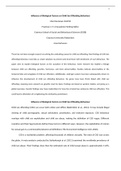1
Influence of Biological Factors on Child Sex Offending Behaviour
Mari Rantanen 562935
Practical 1.7-1.8 Academic Writing Skills I
Erasmus School of Social and Behavioural Sciences (ESSB)
Erasmus University Rotterdam
Liisa Karhunen
There has not been enough research on solving the underlying causes for child sex offending. New findings of child sex
offending behaviour may help us create solutions to prevent and treat those with tendencies of such behaviour. The
paper aims to explain biological factors as the causation of the behaviour. Some research has implied a linkage
between child sex offending, genetics, hormones, and brain abnormalities. Studies indicate abnormalities in the
temporal lobe and amygdala of child sex offenders. Additionally, androgen system has been subsequently shown to
influence the development of child sex offending behaviour. No genes have been firmly linked with child sex
offending, meaning more research on genetics must be done. Findings are based on western studies, not giving us a
global overview. Genetic findings may have implications for how the criminal law sentences child sex offenders. This
could lead to alleviation of or tightening the retributive punishment.
Influence of Biological Factors on Child Sex Offending Behaviour
Child sex offending (CSO) can occur both online and offline (Babchishin et al., 2014). It may include illegal
viewing of child pornography, sexual solicitation, prostitution, and indecent exposure. CSO behaviour
overlaps with child sex exploitation and child sex abuse, making the definition of CSO vague. Different
countries and their legal systems define these terms in different ways. However, the exploitation of minors
for sexual gain is a commonality between all definitions (The Economist Intelligence Unit, 2020).
CSO is a worldwide problem, affecting thousands of children annually. The rates of CSO vary across
the globe. A meta-analysis conducted by Stoltenborgh et al. (2011) examined the worldwide prevalence of
child sex abuse. Their findings show that the estimated rate of child sexual abuse is approximately 11.8%,
, 2
higher prevalence in girls than in boys. Another meta-analysis by Barth et al. (2012) estimated a child sexual
abuse rate of 8 to 31% for girls and 3 to 17% for boys.
Little is known about the nature of child sex offenders. Aetiology of CSO behaviour can be
distinguished into different factors such as genetics, personality, and cognitive distortions. However, it is
important to note that the ambiguous definition of a CSO can influence our understanding of the
underlying causes of CSO behaviour. A common distinction is made between non-paedophilic and
paedophilic CSOs (Dillien et al., 2020). Estimated 40 to 50% of CSOs have a paedophilic interest, meaning
that not all CSOs have a sexual interest in minors. Furthermore, not all paedophiles have a record of CSO
(Schiffer et al., 2017). Both types are considered in this paper.
Nevertheless, there has been a moderate amount, but not enough, of research on both paedophilic
and non-paedophilic CSOs. To find proper treatment for child sex offenders, we must understand the
underlying causes. The focus of this paper is to cover biological findings such as genetics, hormones, and
brain abnormalities, and to what extent these factors influence CSO behaviour. They may explain how CSOs
differ from the general population, drawing a more concrete line between a mentally healthy person and a
child sex offender.
Research shows that paedophilia is found more often in families with a history of paedophilia than
in families of non-paedophiles (Jakubczyk et al., 2016). This finding indicates that there is a genetic
component that might explain sexual interest towards minors. With new, advanced technology, we can use
magnetic resonance imaging (MRI), a positron emission tomography scan, and other interventions to
discover brain abnormalities, regarding brain function and structure.
The Impact of Hormones and Genetics
To begin with hormones, androgens have been linked to sex drive and function, as well as delinquent
behaviour (Kruger et al., 2019). Simply put, androgens are sex hormones that typically include testosterone
which is found in higher levels in males than in females (Kalat et al., 2008). Females, on the other hand,
tend to have higher levels of estrogens than androgens. It is important to mention that both females and





